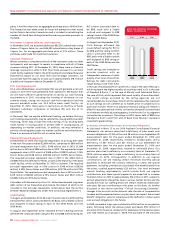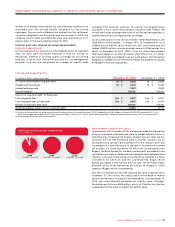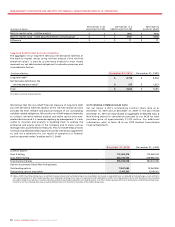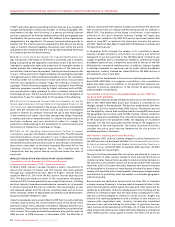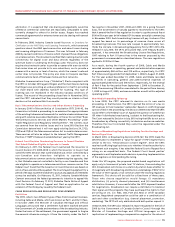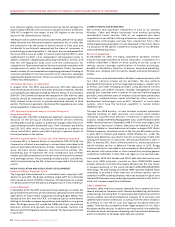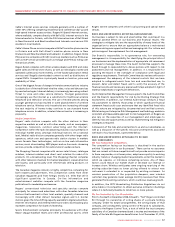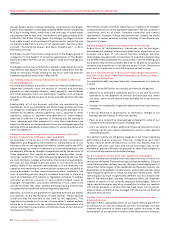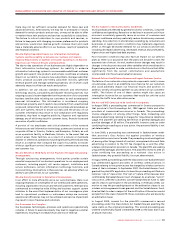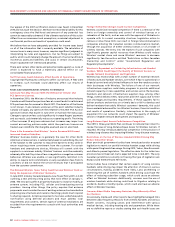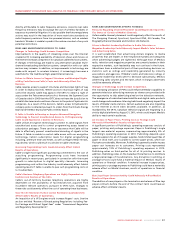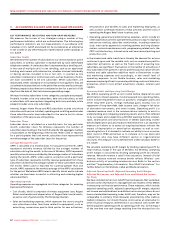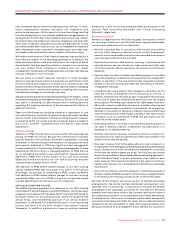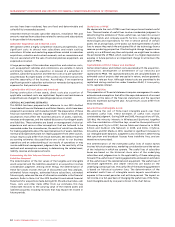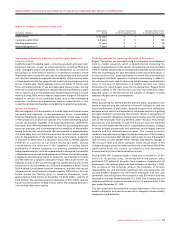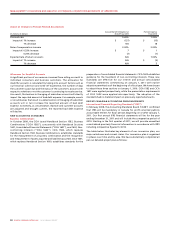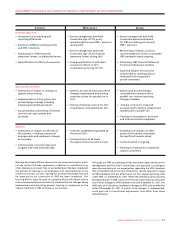Rogers 2010 Annual Report Download - page 53
Download and view the complete annual report
Please find page 53 of the 2010 Rogers annual report below. You can navigate through the pages in the report by either clicking on the pages listed below, or by using the keyword search tool below to find specific information within the annual report.
ROGERS COMMUNICATIONS INC. 2010 ANNUAL REPORT 57
MANAGEMENT’S DISCUSSION AND ANALYSIS OF FINANCIAL CONDITION AND RESULTS OF OPERATIONS
Cable’s Internet access services compete generally with a number of
other ISPs offering competing residential and commercial dial-up and
high-speed Internet access services. Rogers Hi-Speed Internet services,
where available, compete directly with Bell’s DSL Internet service in the
Internet market in Ontario, with the DSL Internet services of Bell Aliant
in New Brunswick and Newfoundland and Labrador and various DSL
resellers in local markets.
Cable’s Home Phone services compete with Bell’s wireline phone service
in Ontario and with Bell Aliant’s wireline phone service in New
Brunswick and Newfoundland and Labrador. In addition, Rogers Home
Phone service competes with ILEC local loop resellers (such as Primus) as
well as VoIP service providers (such as Vonage and Primus) riding over
the services of ISPs.
Rogers Retail competes with other wireless dealers and DVD and video
game sales and rental store chains, as well as individually owned and
operated outlets and, more recently, on-line-based subscription rental
services and illegally downloaded content as well as distributors of
copied DVDs. Competition is principally based on location, price and
availability of titles.
One of the biggest forces of change in the telecommunications industry
is substitution of the traditional wireline video, voice and data services
by new technologies. Internet delivery is increasingly becoming a direct
threat to voice and video service delivery. Younger generations
increasingly use the Internet as a substitute for traditional wireline
telephone and television services. The use of mobile phones among
younger generations has resulted in some abandonment of wireline
telephone service. Wireless-only households are increasing although
the vast majority of homes today continue to use standard home
telephone service. In addition, wireless Internet service is increasing in
popularity.
Media Competition
Rogers’ radio stations compete with the other stations in their
respective markets as well as with other media, such as newspapers,
magazines, television, outdoor advertising and the Internet.
Competition within the radio broadcasting industry occurs primarily in
individual market areas, amongst individual stations. On a national
level, Media’s radio division competes generally with other larger radio
operators, which own and operate radio station clusters in markets
across Canada. New technologies, such as on-line web information
services, music downloading, MP3 players and on-line music streaming
services, provide competition for radio stations’ audience share.
The Shopping Channel competes with various retail stores, catalogue
retailers, Internet retailers and direct mail retailers for sales of its
products. On a broadcasting level, The Shopping Channel competes
with other television channels for channel placement, viewer attention
and loyalty, and particularly with infomercials selling products on
television.
The Canadian magazine industry is highly competitive, competing for
both readers and advertisers. This competition comes from other
Canadian magazines and from foreign, mostly U.S. titles that sell in
significant quantities in Canada. On-line information and
entertainment websites compete with the Canadian magazine
publications for readership and revenue.
Rogers’ conventional television and specialty services compete
principally for viewers and advertisers with other Canadian television
stations that broadcast in their local markets, specialty channels and
increasingly with other distant Canadian signals and U.S. border
stations given the time-shifting capacity available to digital subscribers.
Internet information and entertainment and video downloading also
represent competition for share of viewership.
Sports Entertainment competes principally for audiences with other
Major League Baseball teams and other professional sports, while
Rogers Centre competes with other local sporting and special event
venues.
RISKS AND UNCERTAINTIES AFFECTING OUR BUSINESSES
Our business is subject to risks and uncertainties that could result in a
material adverse effect on our business and financial results. The
strategies to mitigate risks are the responsibility of many levels of the
organization to ensure that an appropriate balance is maintained
between seizing new opportunities and managing risk. Our culture and
policies support the requirement for risk management.
Our Board is responsible, in its governance role, for overseeing
management in its responsibility for identifying the principal risks of
our businesses and the implementation of appropriate risk assessment
processes to manage these risks. The Audit Committee supports the
Board through its responsibility to discuss policies with respect to risk
assessment and risk management. In addition, it is responsible for
assisting the Board in the oversight of compliance with legal and
regulatory requirements. The Audit Committee also reviews with senior
management the adequacy of the internal controls that we have
adopted to safeguard assets from loss and unauthorized use, to
prevent, deter and detect fraud, and to verify the accuracy of the
financial records and review any special audit steps adopted in light of
material weaknesses or significant deficiencies.
Our Enterprise Risk Management Group supports the Audit Committee
and the Board’s responsibility for risk by facilitating Strategic Risk
Assessments. In addition, our Internal Audit Group conducts a fraud
risk assessment to identify those areas in which significant financial
statement fraud could occur and ensure that any identified fraud risks
of this nature are mitigated by documented and verified controls.
While having an Enterprise Risk Management methodology enables a
consistent and measurable approach to risk management, at Rogers we
also rely on the expertise of our management and employees to
identify risks and opportunities as well as implementing risk mitigation
strategies as required.
A discussion of the risks and uncertainties to us and our subsidiaries, as
well as a discussion of the specific risks and uncertainties associated
with each of our businesses, is presented below.
RISKS AND UNCERTAINTIES APPLICABLE TO RCI AND
OUR SUBSIDIARIES
We Face Substantial Competition.
The competition facing our businesses is described in the section
entitled “Competition in our Businesses”. There can be no assurance
that our current or future competitors will not provide services superior
to those we provide, or at lower prices, adapt more quickly to evolving
industry trends or changing market requirements, enter the market in
which we operate, or introduce competing services. Any of these
factors could reduce our market share or decrease our revenue or
increase churn. Wireless anticipates some ongoing re-pricing of the
existing subscriber base as lower pricing offered to attract new
customers is extended to or requested by existing customers. As
wireless penetration of the population deepens, new wireless
customers may generate lower average monthly revenues than those
generated from existing customers, which could slow revenue growth.
In addition, the CRTC Broadcasting Distribution Regulations do not
allow Cable or its competitors to obtain exclusive contracts in buildings
where it is technically feasible to install two or more systems.
We Are Controlled by One Shareholder.
Prior to his death in December 2008, Edward S. “Ted” Rogers controlled
RCI through his ownership of voting shares of a private holding
company. Under his estate arrangements, the voting shares of that
company, and consequently voting control of RCI and its subsidiaries,
passed to the Rogers Control Trust, a trust of which the trust company
subsidiary of a Canadian chartered bank is trustee and members of the
family of the late Mr. Rogers are beneficiaries. As of December 31, 2010,



